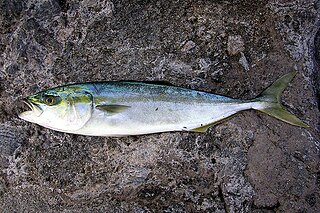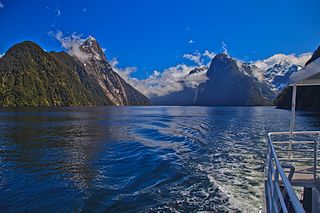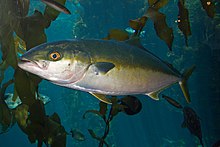
Amberjacks are Atlantic and Pacific fish in the genus Seriola of the family Carangidae. They are widely consumed across the world in various cultures, most notably for Pacific amberjacks in Japanese cuisine; they are most often found in the warmer parts of the oceans. There are many variations of amberjack, including greater amberjack (Atlantic), lesser amberjack (Atlantic), Almaco jack (Pacific), yellowtail (Pacific), and the banded rudderfish (Atlantic). Though most of the Seriola species are considered "amberjacks", the species Seriola hippos is not.

The cobia is a species of carangiform marine fish, the only extant representative of the genus Rachycentron and the family Rachycentridae. Its other common names include black kingfish, black salmon, ling, lemonfish, crabeater, prodigal son, codfish, and black bonito.
A yellowtail may be any of several different species of fish. Most commonly the yellowtail amberjack Seriola lalandi is meant. In the context of sushi, yellowtail usually refers to the Japanese amberjack, Seriola quinqueradiata. Other species called simply "yellowtail" include:

Arripis is a genus of marine fishes from Australia and New Zealand, known as Australian salmon, kahawai and Australian herring. They are the only members of the family Arripidae. Despite the common name, Australian salmon are not related to the salmon family Salmonidae of the Northern Hemisphere, just as Australian herring are not related to herring of the Northern Hemisphere, but belong to the order Perciformes of perch-like fishes. Australian salmon were named so by early European settlers after their superficial resemblance to the salmoniform fishes.

The Japanese amberjack or yellowtail, Seriola quinqueradiata, is a species of jack fish in the family Carangidae, native to the northwest Pacific Ocean. It is known as shiyu (鰤魚) in China, bang'eo (방어) in Korea, and buri or hamachi in Japan.

The rainbow runner, also known as the rainbow yellowtail, Spanish jack and Hawaiian salmon, is a common species of pelagic marine fish of the jack family, Carangidae. The species is widespread throughout the tropical and subtropical waters of the world, inhabiting both coastal and offshore areas. The species is the only member of the genus Elagatis, which was created 15 years after its initial description, and is closely related to the amberjacks. The rainbow runner is easily distinguished by its body shape, and the brilliant colouration which gives the fish its name. It is a fast-swimming predator, taking small fish, cephalopods, and a wide variety of planktonic crustaceans. The species reaches sexual maturity around 60 cm (24 in), and spawning takes place at different times, with some populations spawning year round, while others only spawn at certain times of the year. The species is a well known game fish, taken by a variety of fishing methods, and is a well-regarded table fish. Large numbers of the species are taken as bycatch in tuna- and shark-fishing operations and marketed.

The greater amberjack, also known as the allied kingfish, great amberfish, greater yellowtail, jenny lind, Sea donkey, purplish amberjack, reef donkey, rock salmon, sailors choice, yellowtail, and yellow trevally, is a species of predatory ray-finned fish in the family Carangidae, the jacks and pompanos. It is found in temperate, subtropical, and tropical seas around the world. It is a popular quarry species for recreational fisheries and is important in commercial fisheries. It is the largest species in the family Carangidae.

The longfin yellowtail, also known as the almaco or silvercoat jack, deep-water, falcate, European or highfin amberjack, rock salmon, longfin or yellow kingfish, is a game fish of the family Carangidae; they are in the same family as yellowtail and amberjack. They are carnivorous and feed, both day and night, on other, smaller fish, such as baitfish, small squid, octopus, crab and shrimp. The flesh is thick and dense, like tuna, and easily may be passed off for white albacore if prepared as sushi.

Aquaculture started to take off in New Zealand in the 1980s. It is dominated by mussels, oysters and salmon. In 2007, aquaculture generated about NZ$360 million in sales on an area of 7,700 hectares. $240 million was earned in exports.

Aquaculture in Australia is the country's fastest-growing primary industry, accounting for 34% of the total gross value of production of seafood. 10 species of fish are farmed in Australia, and production is dominated by southern bluefin tuna, Atlantic salmon and barramundi. Mud crabs have also been cultivated in Australia for many years, sometimes leading to over-exploitation. Traditionally, this aquaculture was limited to pearls, but since the early 1970s, there has been significant research and commercial development of other forms of aquaculture, including finfish, crustaceans, and molluscs.

Seriola is a genus of ray-finned fish, with many species commonly known as amberjacks. Nine extant species are currently recognized, although these were formerly split into many more. Also, several species are currently placed in several other genera of the Carangidae that were originally described under Seriola. They are a large, carnivorous finfish popularly known for the firm texture and rich flavour of their flesh, which make them an ideal fish for aquaculture. Because specimens caught can weigh up to 100 kg (220 lb), and are powerful swimmers and hunters, they are also highly prized by sport fisherman.

Trachurus lathami is a species of fish in the family Carangidae and the genus Trachurus, the jack mackerels. Common names include rough scad and horse mackerel in English, as well as chinchard frappeur (French), chicharro garretón (Spanish), jurel, and carapau, garaçuma, surel, and xixarro. It is native to parts of the western Atlantic Ocean, including seas off the eastern coasts of North and South America and the Gulf of Mexico.

Seriola dorsalis, the California yellowtail is a species of ray-finned fish of the family Carangidae. This species is also known by several alternate names, such as amberjack, forktail, mossback, white salmon and yellowtail tunis or tuna or by its Spanish name jurel. Although previously thought to belong to S. lalandi, recent genetic analysis distinguished California yellowtail as a distinct species from the yellowtail amberjack.
Clean Seas Seafood Ltd is an Australian seafood production company specialising in the sea-cage aquaculture of Yellowtail kingfish. It was established by The Stehr Group in 2000, and became the first Australian company fish farming in South Australia to be listed on the ASX in 2005. The company was established by "tuna baron" Hagen Stehr, whose son Marcus remains one of the company's directors. Clean Seas has shore and sea-based fish farming facilities at Arno Bay, aquaculture leases in Fitzgerald Bay and near Port Lincoln and a processing facility at Royal Park in Adelaide. Its tuna interests were originally held by the private company Australian Tuna Fisheries Pty Ltd. Clean Seas' ambition to control and commercialise the lifecycle of the Southern bluefin tuna has not been realised.

The lesser amberjack, also known as the false amberjack or little amberjack, is a species of ray-finned fish from the family Carangidae, the jacks and pompanos.
Fitzgerald Bay is a large bay located between Point Lowly and Backy Point in South Australia's upper Spencer Gulf. The bay's shoreline consists mostly of pebble beaches and sparse grey mangroves. In the 2000s the bay was used for the farming of yellowtail kingfish until their closure circa 2011 in response to high levels of fish mortality. Understanding of the environmental impacts of yellowtail kingfish farming is limited. As of 2021, fish farming has not returned to Fitzgerald Bay, but aquaculture zones remain in place, and Clean Seas is authorised to restock fish farms there. There are approximately forty shacks and coastal homes sparsely distributed along the fringe of Fitzgerald Bay whose interests are represented by the Cultana Jenkins Shackowners' Association.
Fish farming inWestern Australia is an experimental part of the state's seafood sector. Prominent operators and lessees include Indian Ocean Fresh Australia and Huon Aquaculture, and the primary commercial species are yellowtail kingfish in the Mid West aquaculture zone and barramundi in the Kimberley aquaculture zone. Pink snapper is another species considered as a sea cage fish farming prospect. The Mid West aquaculture zone lies between Geraldton and the Abrolhos Islands, and the Kimberly aquaculture zone is in Cone Bay north of Derby. The sector is represented by Erica Starling as spokesperson for the Marine Fishfarmers Association.
Fish farming is a major economic contributor to South Australia's seafood sector. The most valuable species is the Southern bluefin tuna, which is caught in the wild then transferred into sea cages in southern Spencer Gulf where they are fed locally caught sardines. The second most valuable species is the Yellowtail kingfish, which is farmed near Port Lincoln and Arno Bay. A tourist venture called Oceanic Victor located in Encounter Bay allows paying customers the opportunity to swim in a sea cage with the Southern bluefin tuna and handfeed the fish. Prominent companies in the fish farming sector in South Australia include Clean Seas and Tony's Tuna International.

Piopiotahi Marine Reserve is a marine reserve covering an area of 690 hectares in the Milford Sound / Piopiotahi, in Fiordland on New Zealand's South Island. It was established in 1993 and is administered by the Department of Conservation.


















